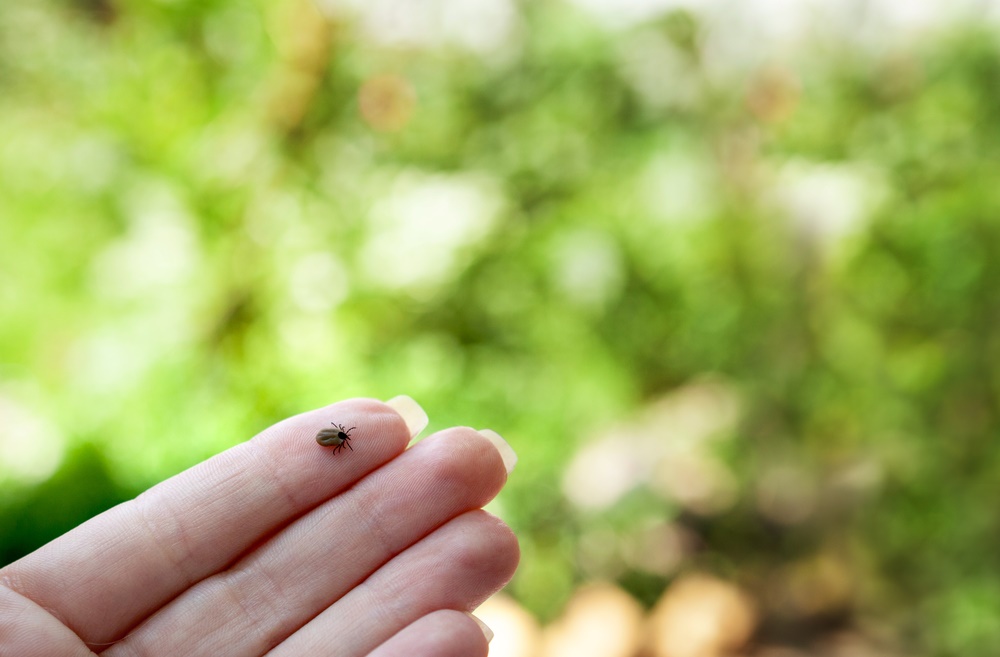Ways to Prevent Tick Bites
Updated November 20, 2020
It’s pretty well known at this point that many ticks carry dangerous illnesses so it can be alarming finding a tick on your skin, especially so if they are already burrowed in. The best way to prevent having a tick bite you is preventing them from getting on your skin altogether, they do say an ounce of prevention is worth a pound of cure after all. We recommend getting your property sprayed for ticks to eliminate these pests on your property of course, but we can’t protect everywhere! If you are hiking, camping, or on vacation, here are some strategies to avoid being bitten by a tick.
- Know where the ticks live – Ticks prefer to live in the tall grass and leaves and brush, they need to stay hydrated or they will dry out and die. We are deeply concerned to update this information this year in regards to the Lone Star Tick as it is now being found in the short grass in the middle of private lawns.During the fall and winter months, ticks emerge during days when the temperatures reach at least 40 degrees. They will hatch from woodpiles, leaf piles, mulch, and other piles of debris.
- Know how ticks hunt – Ticks hunt by “questing”; they hydrate near the soil, then they climb up on a plant and hang off of the edge to wait for a human or animal to brush past them. Ticks are attracted to CO2 (carbon dioxide from your breath), CO (carbon monoxide from your car exhaust), and heat. Again, we must update this information in regards to the Lone Star Tick; this tick exhibits highly aggressive behaviors and has been found hunting in areas previously regarded as safe – i.e. the middle of your lawn. Although these particular ticks are becoming increasingly aggressive in regards to their outdoor hunting habits, no ticks want to come inside your home. If you are finding ticks inside your home, they are hitching a ride on a human or animal! If a tick ends up inside your home, chances are it will not live very long as it will die of desiccation (drying out) within a day or so.
- Be familiar with the species. Long Island is natives to 3 species of hard-shell ticks: deer ticks, Lone Star ticks, & og ticks. Hardshell ticks come in male/female and 3 sizes: small (larvae), medium (nymph), and large (adult). The actual sizes are somewhere between a poppy seed, a sesame seed, and a very small watermelon pit.
- Be aware of seasonal tick activity. Ticks are active and alive, nearly year-round and yes, even in the winter. They are just less active as the weather is cold. They can freeze under a pile of leaves and then start crawling around again when they warm up.
- Understand that not all ticks carry diseases. There are studies underway to determine exact probabilities, but suffice it to say that if you are bitten by a tick, your chances of becoming ill with a tick-borne disease are roughly 50/50.
- Protect yourself when outside in areas where ticks will be:
- Spray your shoes with Permethrin tick repellent – #1 preventative strategy, some studies report that this decreases your chances of tick bite by up to 80%.
- Carry duct tape around your water bottle when out in nature. This will help you trap and suffocate any ticks you find crawling on you before they bite.
- Use a lint roller to roll your clothing after spending time in the woods and catch any ticks crawling on you.
- Wear light-colored clothing & if you will be in the woods wear socks pulled up over a pair of light pants, and spray your shoes, socks, and pants with Permethrin.
- Have a tick kit ready to remove a tick the minute you find one attached to you. Removing a tick quickly greatly reduces your chances of acquiring a tick-borne illness. If you do not have one of these, Southampton Hospital provides them for free: just call the Tick-Borne Disease Resource Center at 631-726-TICK.
- Protect Your Pets: Make sure that your pet is wearing some form of tick repellant. For animals, you can buy a tick and flea collar, use oil that goes between their shoulder blades, use sprays or shampoos that repel ticks, or you can get chewable pills from your veterinarian that your pet eats once a month. Keep your pet on a leash and out of tick habitats. Do not sleep with your pet unless you have performed a thorough tick check.
- Protect Your Yard: Remove all tick habitats that are reasonable: leaves and brush, bird feeders, ornamental plantings, woodpiles, and keep the grass short! If you are unsure if there are ticks in your yard, make a tick flag and drag for ticks. If you find ticks on your flag (a flannel pillowcase attached to a pole), call East End Tick & Mosquito Control® for a tick treatment at (631) 287-9700 in Southampton, (631) 324-9700 in East Hampton, or (631) 765-9700 in Southold.
We hope this advice is helpful to everyone out there. We hope you can stay safe and be prepared.


